Bright Side of the Night – 2.2.9
Fungi
Fungi are widespread. The vast majority are land-dwelling. Fungi feed on organic nutrients in their environment, which they usually break down by releasing enzymes, thereby making them soluble and available to themselves. According to today’s science, fungi are more closely related to animals than to plants.
Talking Fungi
A study published in 2022[1] examined the electrical impulses of the hyphae of some fungal species. The phases of electrical activity were species-specific and lasted from one to 21 hours. According to the study, some fungal species use up to 50 “words”, 15-20 of which are used more frequently. This means fungi possibly communicate with each other through these electrical impulses, similar to the way trees communicate via their roots, or to neuronal networks.
Turning Night into Day
Fungi do not follow a daily rhythm, just like animals or plants; those that do are an exception. Mycelia mostly grow in the dark. When hyphal tips reach the surface of the substrate exposed to light, the light – or more precisely, its blue components – stimulates the formation of spores. The development of fruiting bodies can also be light-dependent.
Glowing Fungi
The following fungi have the gift of bioluminescence. Similar to the firefly, the glow is caused by a chemical reaction involving the enzyme luciferase. It is unclear why fungi glow. Possible explanations are that it is to scare off predators or to attract insects that can help spread the fungal spores.
Honey Fungus
The Honey Yellow Hallimasch (Armillaria mellea) is found almost worldwide and is relatively common in Europe. The fungus occurs mainly in parks, gardens and on root wood in meadows. It primarly colonizes deciduous wood. The fruiting bodies appear in late summer and autumn. It grows on rotten, dead wood and on weakened trees. The parasitic infestation of the fungus leads to the death of the host tree. Wood infested with mycelium glows green-yellow in the dark under certain weather conditions. This bioluminescence is also known in other Hallimasch species found in Europe.
Dark Olive Tree Trumpet Mushroom
The warmth-loving dark olive (Omphalotus olearius) is widespread and fairly common in the Mediterranean region, but very rare in Central Europe. Its mycelium and lamellae show the phenomenon of bioluminescence. This fungus lives on dead and dying deciduous tree wood and usually grows in clumps on olive trees, sometimes also on oaks or sweet chestnuts. The fruiting body appears from July to October. The dark olive tree funnel cake is very poisonous, although not lethal.
[1] Andrew Adamatzky. 2022. Language of fungi derived from their electrical spiking activity. R. Soc. open sci 9 (4): 211926; doi: 10.1098/rsos.211926


Further Resources
Links below will redirect you to external websites. In accordance with the European data protection declarations, we would like to point out that by clicking on these links you may send data to external providers. We cannot prevent that.
Images
![]() Glowing Hallimasch. Image by Katrin Lugerbauer.
Glowing Hallimasch. Image by Katrin Lugerbauer.
Videos
![]() Glow-in-the-Dark Mushrooms: Nature’s Night Lights | National Geographic
Glow-in-the-Dark Mushrooms: Nature’s Night Lights | National Geographic
![]() Documentary: Bioluminescent Creatures (National Geographic)
Documentary: Bioluminescent Creatures (National Geographic)
 I funghi possono emettere luce? – Lucy Scienza
I funghi possono emettere luce? – Lucy Scienza
Online Resources
![]()
 The influence of light pollution on plants, animals and ecosystems (Helle Not)
The influence of light pollution on plants, animals and ecosystems (Helle Not)
![]()
 Verlust der Nacht / Loss of the Night: Interdisciplinary Research network
Verlust der Nacht / Loss of the Night: Interdisciplinary Research network
![]() Into the Night in the Kaunertal Valley (Online publication)
Into the Night in the Kaunertal Valley (Online publication)
 Unterwegs in die Nacht im Kaunertal (Online publication)
Unterwegs in die Nacht im Kaunertal (Online publication)
 Konzept zur nachtbezogenen Naturpädagogik (Online publication)
Konzept zur nachtbezogenen Naturpädagogik (Online publication)
 Foresta Atlantica del Brasile: che cosa sono i funghi bioluminescenti? – Focus
Foresta Atlantica del Brasile: che cosa sono i funghi bioluminescenti? – Focus
Further Readings
![]()
 Regularly updated Literature and links with regards to light pollution and dark skies (Helle Not)
Regularly updated Literature and links with regards to light pollution and dark skies (Helle Not)
![]()
 Literature & Links on the website “Verlust der Nacht/Loss of the Night”
Literature & Links on the website “Verlust der Nacht/Loss of the Night”
![]() Scientific paper: Language of fungi derived from their electrical spiking activity. (2020)
Scientific paper: Language of fungi derived from their electrical spiking activity. (2020)
Teaching Material
For Kids
![]()
 Materials for young scientists: Quiz, Arts and craft corner, App and Exhibition for schools. (Loss of the Night network)
Materials for young scientists: Quiz, Arts and craft corner, App and Exhibition for schools. (Loss of the Night network)
 Unterrichtsmaterialien für Schulen – “Tierprofi Wildtiere” (Die Umweltberatung)
Unterrichtsmaterialien für Schulen – “Tierprofi Wildtiere” (Die Umweltberatung)
 Unterrichtsmaterialien für Schulen – “Lichtverschmutzung” (Die Umweltberatung)
Unterrichtsmaterialien für Schulen – “Lichtverschmutzung” (Die Umweltberatung)
 Wissens- und Methodenbox “Kunstlicht, Nacht und Sternenhimmel“ (Naturfreunde)
Wissens- und Methodenbox “Kunstlicht, Nacht und Sternenhimmel“ (Naturfreunde)
